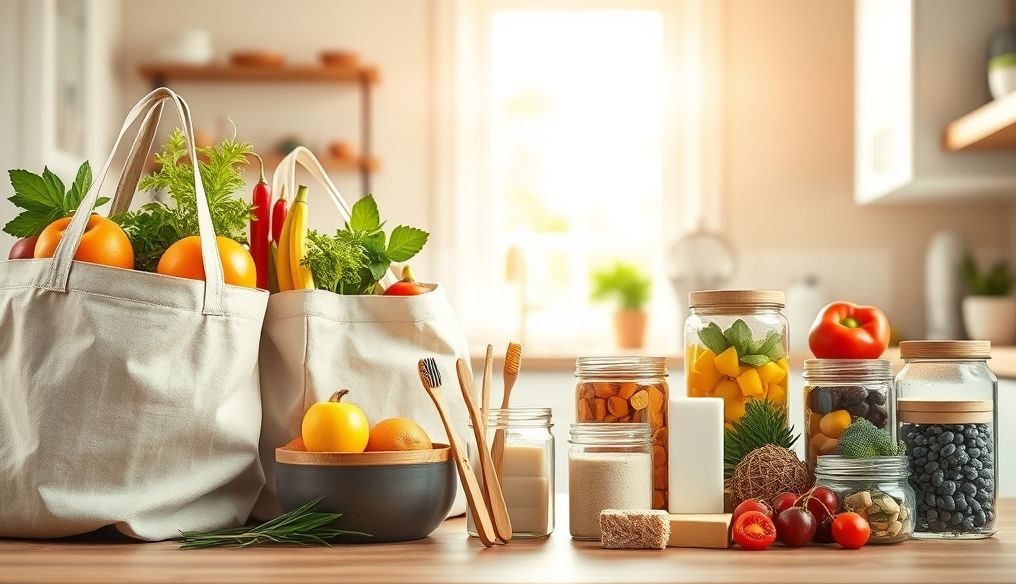Introduction: Why Should We Reduce Plastic Use?
Plastic is a versatile and inexpensive material, but it is also one of the biggest environmental challenges facing our planet. It takes hundreds of years to decompose, accumulates in the oceans, harms wildlife, and contributes to soil pollution. In addition, harmful chemicals can leach from plastic into our food and drinks, posing potential health risks.
Chapter 1: Plastic in the Kitchen: How to Reduce Consumption?
1.1. Replace Plastic Bags with Reusable Cloth Bags
Plastic bags are one of the most common types of plastic waste. Replace them with durable, reusable cloth bags when shopping. Keep some bags in your car or purse so you are always prepared.
1.2. Use Glass or Metal Containers to Store Food
Avoid using plastic bags or plastic containers to store food. Replace them with airtight glass or metal containers. These containers are healthier and more sustainable.
1.3. Buy Products in Bulk and Reduce Packaging
When shopping, look for products that are sold in bulk or that have as little packaging as possible. You can also buy products from local markets that allow you to bring your own containers.
1.4. Prepare Meals at Home
Eating at home reduces reliance on takeaway meals that often come in plastic packaging. Plan your meals in advance and prepare your own food.
1.5. Use Kitchen Utensils Made of Natural Materials
Replace plastic utensils with utensils made of wood, bamboo, or stainless steel. These materials are more sustainable and healthy.
Chapter 2: Plastic in the Bathroom: Eco-Friendly Alternatives
2.1. Use Solid Soap and Solid Shampoo Instead of Liquid
Solid soap and shampoo come without plastic packaging. Look for natural and organic products.
2.2. Use a Bamboo Toothbrush
Plastic toothbrushes are a major source of waste. Replace them with a bamboo toothbrush, which is a biodegradable material.
2.3. Use a Reusable Metal Razor
Avoid using disposable plastic razors. Replace them with a reusable metal razor.
2.4. Use Reusable Organic Cotton Pads
Replace plastic cotton pads with reusable organic cotton pads for cleaning your face and removing makeup.
Chapter 3: Plastic at Work and School: Sustainable Options
3.1. Carry a Reusable Water Bottle
Avoid buying plastic water bottles. Carry a reusable water bottle and refill it throughout the day.
3.2. Use a Reusable Lunch Box
Instead of using plastic bags or plastic containers to pack your lunch, use a reusable lunch box.
3.3. Use Wooden Pencils and Refillable Pens
Avoid using disposable plastic pens. Use wooden pencils or refillable pens.
Chapter 4: Plastic in Travel and Adventures: Reducing Waste
4.1. Carry Your Own Cutlery
When traveling, carry your own cutlery made of stainless steel or bamboo to avoid using disposable plastic utensils.
4.2. Use Eco-Friendly Travel Bags
Look for travel bags made from recycled materials or natural materials.
4.3. Avoid Using Small Personal Care Products
Instead of using small personal care products that come in small plastic packaging, carry refillable containers.
Chapter 5: Plastic in Shopping: Conscious Decisions
5.1. Support Companies That Use Sustainable Packaging
Look for companies that are committed to sustainability and use eco-friendly packaging materials.
5.2. Buy Local Products
Buying local products reduces the need for packaging and transportation.
5.3. Refuse Plastic Bags
When shopping, refuse plastic bags and use your own cloth bags.
Chapter 6: Plastic in Events and Celebrations: Innovative Alternatives
6.1. Use Reusable Plates and Cups
At events and celebrations, use reusable plates and cups instead of disposable plastic plates and cups.
6.2. Use Decorations Made of Natural Materials
Replace plastic decorations with decorations made of paper, wood, or natural flowers.
6.3. Serve Food in Reusable Dishes
Serve food in reusable dishes instead of disposable plastic dishes.
Chapter 7: Repair and Reuse: A Culture of Sustainability
7.1. Repair Products Instead of Replacing Them
When a product breaks down, try to repair it instead of replacing it with a new one.
7.2. Reuse Plastic Containers
Reuse plastic containers to store things or to make art projects.
7.3. Donate Things You No Longer Need
Donate things you no longer need instead of throwing them away.
Chapter 8: Awareness and Education: Spreading Environmental Awareness
8.1. Talk to Family and Friends About the Importance of Reducing Plastic Use
Share information about the impact of plastic on the environment with your family and friends.
8.2. Support Environmental Organizations
Donate to environmental organizations that work to protect the environment and reduce plastic pollution.
8.3. Participate in Cleanup Campaigns
Participate in cleanup campaigns to remove plastic waste from beaches and parks.
Conclusion: A Plastic-Free Future
Reducing plastic use is a collective responsibility. By taking small steps in our daily lives, we can make a big difference in protecting the environment and ensuring a more sustainable future for generations to come.
Important Statistics:
- More than 300 million tons of plastic are produced each year.
- About 8 million tons of plastic enter the oceans each year.
- Plastic takes hundreds of years to decompose.
Additional Tips:
- Look for eco-friendly alternatives to plastic products.
- Reduce your consumption of products that come in plastic packaging.
- Recycle plastic properly.




